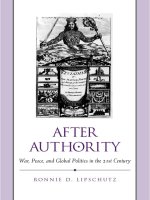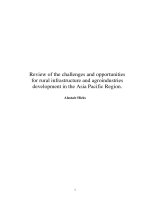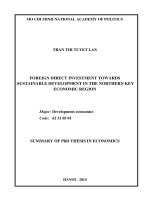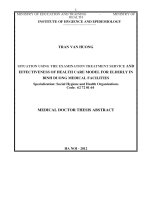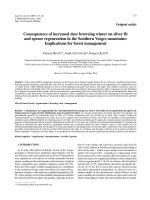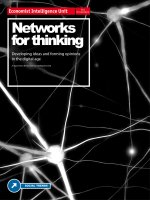Effectiveness of foreign aid projects for climate change response and sustainable development in the vietnamese mekong river delta
Bạn đang xem bản rút gọn của tài liệu. Xem và tải ngay bản đầy đủ của tài liệu tại đây (4.83 MB, 201 trang )
VIETNAM NATIONAL UNIVERSITY, HANOI
VIETNAM JAPAN UNIVERSITY
LE THI NGOC DIEP
EFFECTIVENESS OF
FOREIGN AID PROJECTS FOR
CLIMATE CHANGE RESPONSE AND
SUSTAINABLE DEVELOPMENT
IN THE VIETNAMESE
MEKONG RIVER DELTA
MASTER'S THESIS
Hanoi, 2021
VIETNAM NATIONAL UNIVERSITY, HANOI
VIETNAM JAPAN UNIVERSITY
LE THI NGOC DIEP
EFFECTIVENESS OF
FOREIGN AID PROJECTS FOR
CLIMATE CHANGE RESPONSE AND
SUSTAINABLE DEVELOPMENT
IN THE VIETNAMESE
MEKONG RIVER DELTA
MAJOR: CLIMATE CHANGE AND DEVELOPMENT
CODE: 8900201.02QTD
RESEARCH SUPERVISOR:
Dr. Nguyen Van Quang
Hanoi, 2021
PLEDGE
In writing this Master's thesis, I carefully read the Decision on the issuance of the
Master's thesis guideline at Vietnam Japan University, fully understand what is
written there, and comply with all the related rules and guidelines.
I assure that this thesis is the result of my own research and has not been published.
I affirm that any third party concept, research, logic, or analysis borrowed is
correctly and appropriately indicated, explicitly and transparently. In this way, the
source is instantly identifiable in citation styles and the author's rights. I am aware
that not documenting source material or not citing clearly, correctly, and completely
constitutes plagiarism.
Le Thi Ngoc Diep
ACKNOWLEDGMENT
Firstly, I would like to express my gratitude to my supervisor, Dr. Nguyen Van
Quang, for giving me helpful guidance and suggestions and for welcoming all of
my questions and concerns. I also would like to thank Dr. Kotera Akihiko, MSc.
Bui Thi Hoa and other lecturers, staff of Vietnam Japan University (VJU), and
Ibaraki University for their contribution towards my exciting journey in VJU.
I am also very grateful to the Japan International Cooperation Agency (JICA)
Vietnam Office for the great internship that assisted me in finishing the research
related to foreign aid projects in the Mekong Delta in Vietnam. My special thanks
go to Dr. Nguyen Thanh Ha, Mr. Ishimaru Hiroki, who gave me so much
meaningful advice, helping me contact Can Tho University, and local authorities in
the Mekong Delta.
I also would like to extend my appreciation to the Agriculture Project Management
Board, Ministry of Agriculture and Rural Development; Development Partners
supporting Vietnam's sustainable development; People's Committee of An Giang
Province, Dong Thap Province, Long An Province, Tien Giang Province, Ben Tre
Province, Vinh Long Province, Can Tho Municipality, Kien Giang Province, Ca
Mau Province, Bac Lieu Province, Hau Giang Province, Soc Trang Province, Tra
Vinh Province; and Can Tho University.
Finally, I would like to thank my friends in VJU, people I met during the internship,
and my family, those who treated me so well. I appreciate your role in helping me
conduct this study.
Le Thi Ngoc Diep
TABLE OF CONTENT
Page
PLEDGE
ACKNOWLEDGMENT
TABLE OF CONTENT
LIST OF TABLES ..................................................................................................... i
LIST OF FIGURES.................................................................................................. ii
LIST OF ABBREVIATIONS ................................................................................. iv
CHAPTER 1: INTRODUCTION ............................................................................1
1.1 The necessity of research ....................................................................................... 1
1.2 The research questions and hypotheses ................................................................. 3
1.3 Research objectives and tasks ................................................................................ 3
1.4 Objects and scope of the research .......................................................................... 5
1.5 Matrix of learning outcomes for the master's thesis .............................................. 5
1.6 Literature review .................................................................................................... 8
1.6.1 Theoretical basis ..........................................................................................8
1.6.2 Political basis ............................................................................................ 11
1.6.3 Related previous studies ............................................................................18
1.7 Study area............................................................................................................. 20
1.7.1 Natural features .........................................................................................20
1.7.2 Socio-economic features ............................................................................23
CHAPTER 2: METHODOLOGY .........................................................................28
2.1 Research approach ............................................................................................... 28
2.2 Research methods ................................................................................................ 28
2.2.1 Data collection...........................................................................................30
2.2.2 Data analysis .............................................................................................32
2.2.3 Cross-SWOT analysis ................................................................................34
2.2.4 Statistical analysis .....................................................................................34
2.2.5 Pearson's Correlation Coefficient Test ......................................................35
2.2.6 Mapmaking ................................................................................................37
CHAPTER 3: OVERVIEW OF ISSUES IN THE VMD .....................................38
3.1 Climate change and climate change impacts ....................................................... 38
3.1.1 Sea-level rise ..............................................................................................38
3.1.2 Drought and salinization ...........................................................................41
3.1.3 Flood ..........................................................................................................43
3.1.4 Coastal erosion and river erosion .............................................................45
3.1.5 Sustainable development in the context of climate change in the VMD ...46
3.2 Upstream reservoir and water transfer ................................................................. 49
3.3 Land subsidence ................................................................................................... 50
3.4 Land use land cover change ................................................................................. 51
3.5 Population growth and migration ........................................................................ 52
3.6 Other issues .......................................................................................................... 54
3.7 Sub-conclusion ..................................................................................................... 54
CHAPTER 4: THE EFFECTIVENESS OF FOREIGN AID PROJECTS FOR
CLIMATE CHANGE RESPONSE AND SUSTAINABLE DEVELOPMENT
IN THE VMD...........................................................................................................60
4.1 The status of foreign aid projects from 2010-2020 in the VMD ......................... 60
4.2 The effectiveness of foreign aid projects ............................................................. 70
4.2.1 Characteristic of aid effectiveness principles in the VMD ........................70
4.2.2 Correlation analysis result ........................................................................72
4.3 Driving forces and factors affecting the effectiveness of
foreign aid projects in VMD ...................................................................................... 75
4.3.1 Aid allocation .............................................................................................75
4.3.2 Fund ...........................................................................................................77
4.3.3 Coordination between stakeholders ..........................................................79
4.3.4 Law/ policy.................................................................................................82
4.3.5 Human resources .......................................................................................83
CHAPTER 5: PROPOSAL OF SOLUTIONS, RECOMMENDATIONS TO
IMPROVE THE EFFECTIVENESS OF FOREIGN AID PROJECTS
CLIMATE CHANGE RESPONSE AND
FOR
SUSTAINABLE DEVELOPMENT
...................................................................................................................................84
5.1 General principles ................................................................................................ 84
5.2 Solutions, recommendations to improve the effectiveness
of foreign aid projects ................................................................................................ 84
5.2.1 Recommendations regarding aid allocation ..............................................86
5.2.2 Recommendations regarding fund .............................................................87
5.2.3 Recommendations regarding coordination ................................................89
5.2.4 Recommendations regarding law/ policy ..................................................91
5.2.5 Recommendations regarding human resources .........................................92
CHAPTER 6: CONCLUSION ...............................................................................94
6.1 Conclusions .......................................................................................................... 94
6.2 Limitations of the research .................................................................................. 95
6.3 Recommendations for further study .................................................................... 96
REFERENCES ........................................................................................................97
APPENDIX ............................................................................................................104
Appendix A: Interview questions for experts, staff in foreign aid agency .............. 104
Appendix B: Interview questions for local authority .............................................. 106
Appendix C: Interview questions for local people .................................................. 109
Appendix D: The number of donors and their projects in VMD
in the 2010-2020 period collected by the author ..................................................... 112
Appendix E: Detail sources of data ......................................................................... 116
Appendix F: Average exchange rate during 2010-2020 applied in this research .... 119
Appendix G: Major driving forces, factors affecting foreign aid effectiveness
according to results from interviews with donors and local authorities .................. 120
Appendix H: Matrix of foreign aid projects in the VMD,
used variables in Correlation Test, SDGs, and CCR ............................................... 121
Appendix I: Matrix of this research and related variables in correlation test,
SDGs, climate change response ............................................................................... 186
LIST OF TABLES
Page
Table 1.1: Research questions and hypothesis of the study ............................................ 3
Table 1.2: Objectives and tasks of the study ................................................................... 4
Table 1.3: Relations between results of the Master's thesis and MCCD's
Program Learning Outcomes (PLOs) ................................................................... 6
Table 1.4: Priority level by sector in the VMD ............................................................. 12
Table 1.5: Priority sectors in the attraction and use of ODA and preferential loans
............................................................................................................................ 15
Table 2.1: Methods of the study .................................................................................... 28
Table 2.2: Secondary data of the research ..................................................................... 31
Table 2.3: CCR options to classify adaptation projects ................................................ 33
Table 2.4: Strategies under Cross-SWOT analysis ....................................................... 34
Table 2.5: Formula of mean, standard deviation ........................................................... 35
Table 2.6: Used variables in Correlation Coefficient Test ............................................ 35
Table 3.1: Inundation Percentage (% area) corresponding to
sea-level rise of 100cm ....................................................................................... 40
Table 3.2: Effects of 2019-2020 drought & saline intrusion ......................................... 42
Table 3.3: Strengths, weaknesses, opportunities, and threats of the VMD ................... 55
Table 3.4: Actionable strategies in the VMD ................................................................ 56
Table 3.5: Serious climate change-related issues and most affected provinces
in the past ten years & present, and in the future ............................................... 57
Table 3.6: Descriptions of sub-regions in the VMD ..................................................... 58
Table 4.1: Total number and cost of aid projects by CCR options ............................... 64
Table 4.2: Descriptive statistics of variables ................................................................. 73
Table 4.3: Result of Pearson's Correlation Coefficient Test.......................................... 73
Table 5.1: Analysis of major stakeholders in the VMD ................................................ 81
i
LIST OF FIGURES
Page
Figure 1.1: Analytical framework of the research......................................................... 11
Figure 1.2: Policy framework of the research ............................................................... 17
Figure 1.3: Mekong Delta in Vietnam with land use map ............................................ 21
Figure 1.4: Average precipitation from 1977 to 2018 in VMD (mm) ........................... 22
Figure 1.5: Population density in 2019 (person/km2) ................................................... 24
Figure 1.6: Current status of economic structure and scale and GRPD per capita
in 2019 in VMD ................................................................................................. 25
Figure 1.7: Transportation in the VMD......................................................................... 26
Figure 2.1: Methodological framework of the research ................................................ 30
Figure 3.1: Sea-level rise scenarios based on the RCP8.5 scenario (cm) ..................... 39
Figure 3.2: The inundation risk map with sea-level rise of 100cm............................... 40
Figure 3.3: Map of 4g/l isohaline from 2013 to 2019 in the VMD............................... 42
Figure 3.4: Simulation map of the flood situation with a frequency of 10%................ 45
Figure 3.5: Erosion sites from 2010-2020 in the VMD ................................................ 46
Figure 3.6: Location Map of Present and Future Hydropower Dams in
Lower Mekong Basin ........................................................................................ 49
Figure 3.7: Land subsidence rate (cm/year) in the VMD ............................................. 50
Figure 3.8: Land use and land cover classification map in VMD ................................. 51
Figure 3.9: Natural population growth rate & Net migration rate in the VMD ............ 52
Figure 3.10: The migration rate (%) in 2019 and the change in population between
2009 and 2019 ................................................................................................... 53
Figure 3.11 Regional division for the past ten years and present ................................. 58
Figure 3.12: Regional division in future ....................................................................... 59
Figure 4.1: Total aid transfer during 2010-2020 in the VMD ....................................... 61
Figure 4.2: Total aid transfer by province in the 2010-2020 period in the VMD ......... 62
Figure 4.3: Total aid transfer by SDGs during 2010-2020............................................ 63
Figure 4.4: Total aid transfer for climate action during 2010-2020 .............................. 65
Figure 4.5: Climate change & green growth public investment share
by theme in the VMD in the 2015-2017 period .............................................. 62
Figure 4.6: Foreign aid for climate change-related issues during 2010-2020 .............. 67
Figure 4.7: Total aid for drought & salinization by province during 2010-2020.......... 68
Figure 4.8: Total aid for erosion by province during 2010-2020 .................................. 69
ii
Figure 4.9: Total aid for flood by province during 2010-2020 ..................................... 69
Figure 4.10: Total aid for sea-level rise by province during 2010-2020....................... 70
Figure 4.11: Graphs depicting the value distribution of X & each Y ........................... 74
Figure 4.12: Effective level several projects in Ninh Kieu, Can Tho and Binh Phuoc
Xuan, Cho Moi, An Giang according to author’s interview result.................... 76
Figure 4.13: Effective level of Project A according to author’s interview result.......... 81
iii
LIST OF ABBREVIATIONS
ADB
Asian Development Bank
AFD
L'Agence Franỗaise de Dộveloppement
(English: The French Development Agency)
CCA
Climate Change Adaptation
CCM
Climate Change Mitigation
CCR
Climate Change Response
DAC
Development Assistance Committee
GIZ
Deutsche Gesellschaft für Internationale Zusammenarbeit
(English: German Corporation for International Cooperation
GmbH)
GRDP
Gross Regional Domestic Product
IFAD
International Fund for Agricultural Development
IPCC
Intergovernmental Panel on Climate Change
JICA
Japan International Cooperation Agency
KfW
Kreditanstalt Für Wiederaufbau
(English: German Development Bank)
MARD
Ministry of Agriculture and Rural Development
MDWG
Mekong Delta Working Group
MONRE
Ministry of Natural Resources and Environment
MPI
Ministry of Planning and Investment
NGO
Non-Governmental Organization
ODA
Official Development Assistance
OECD
Organization for Economic Co-operation and Development
PCI
Province Competitive Index
SDGs
Sustainable Development Goals
SP-RCC
Support Program to Respond to Climate Change
USAID
United States Agency for International Development
VMD
Vietnamese Mekong River Delta
WB
World Bank
iv
CHAPTER 1: INTRODUCTION
1.1 The necessity of research
Climate change is one of the enormous challenges of the 21st century due to its
global origins, global consequences, and long-term impacts (Webersik, 2010). The
Earth's climate has changed for millions of years. However, human activities
worldwide, especially burning fossil fuels, are exceedingly likely to be the crucial
factor that shapes the recent observed global warming (IPCC, 2018). Increasing
temperature and precipitation changes affect food and water supplies, leading to
many plant and animal species extinction. Climate change also causes sea-level rise,
generating the disappearance of low-lying areas. Besides the impacts on the
environment, climate change seriously threatens human development and prosperity
(Huang & Pascual, 2018).
Developing countries are more vulnerable to that inauspicious situation than
developed countries due to their low adaptive capacity, weak regulatory systems,
and close dependence on natural resources (Wijaya, 2014). They need assistance
from other countries to support their endeavors to achieve sustainable development
goals. Therefore, foreign aid, defined by the international transfer of capital, goods,
or services from a government or a non-government organization for several
reasons, has played an essential role in increasing prosperity in needed countries
(Huang & Pascual, 2018). For that reason, the effectiveness of foreign aid projects
is one of the essential factors contributing to sustainable development throughout
the world (United Nations Economic and Social Council, 2008).
Located in the south of Vietnam, the Vietnamese Mekong River Delta (VMD) is the
home of around 17.27 million people. The VMD area is nearly 4 million ha, and
67.5% of the VMD area is agricultural land (Vo & Huynh, 2014). The VMD is also
1
a global hotspot regarding the changing climate (Entzinger & Scholten, 2016).
Several climate change-induced hazards appear in the area, including sea-level rise,
salinization, inundation, water scarcity, changes in temperature and precipitation
(Vo & Huynh, 2014). Those hazards have strongly affected agricultural and
aquaculture activities, damaging the VMD's sustainable development and causing
significant migration flows in the south of Vietnam (Entzinger & Scholten, 2016).
Vietnamese government adopted many official documents towards achieving
sustainable development on both national scale and regional scale. Some of them
are "Viet Nam Sustainable Development Strategy for 2011-2020" (Prime Minister,
2012), "National Action Plan for the Implementation of the 2030 Sustainable
Development Agenda" (Prime Minister, 2017), "Resolution number 120/NQ-CP on
Sustainable and Climate-Resilient Development of the Mekong Delta of Vietnam"
(Government, 2017; Prime Minister, 2019). Those documents have provided
specific orientations to projects and activities for Vietnam's sustainable
development. Due to the limitation of capital resources, human resource's capacity
to implement activities, projects, the Vietnamese government has asked for help
from other resources, including foreign resources.
Many donors such as World Bank (WB), Asian Development Bank (ADB), Japan
International Cooperation Agency (JICA), and Deutsche Gesellschaft für
Internationale Zusammenarbeit (GIZ) have organized projects (usually Official
Development Assistance (ODA) projects) to support local government and local
people to deal with this urgent call in the VMD. However, there is increasing
concern about the foreign aid projects' effectiveness in general, driving forces and
factors affecting aid effectiveness. Because the number of research related to the
problems listed above in the VMD is limited and not wide published, an in-depth
study is needed in the study area.
2
1.2 The research questions and hypotheses
Table 1.1 shows the research questions and hypotheses of the study.
Table 1.1: Research questions and hypothesis of the study
Research questions
-
What
are
the
affecting
main
Hypothesis
issues -
Many issues are affecting sustainable
sustainable
development in the VMD, in which
development in the past, present,
climate change is one of the main
and future in the Mekong Delta
issues in the past, present and future
in Vietnam?
-
How is the effectiveness of -
Generally, international aid projects
foreign aid projects for climate
are ineffective in contributing to
change response and sustainable
sustainable development in the VMD
development in the Mekong
in the context of climate change due to
Delta in Vietnam?
improper focusing issues, focusing on
Sustainable
Development
Goals
(SDGs), and financial distribution
among provinces
-
What are the driving forces and -
Aid allocation, fund, coordination
factors
between stakeholders, law/ policy, and
affecting foreign aid
effectiveness in the VMD?
human resources are driving forces
and factors affecting international aid
effectiveness in the VMD
-
How to improve the foreign aid -
Efforts from all stakeholders are
projects'
needed for effective foreign assistance
effectiveness
for
climate change response (CCR)
projects.
and sustainable development in -
Projects should be focused on main
the VMD?
climate change issues at present and in
the future and prioritized in the most
vulnerable areas to climate change in
the VMD
1.3 Research objectives and tasks
The research's objectives and tasks are described in Table 1.2.
3
Table 1.2: Objectives and tasks of the study
Objectives
Tasks
Ob1: Clarifying main issues -
Collecting data about natural, socio-economic
affecting
features, issues in the VMD
sustainable
development in the past, -
Collecting
data
about
climate
change
present, and future in the
scenarios,
climate change impacts in the
VMD
study area
-
Interviewing with experts, local people
-
Narrative analysis to identify central issues in
the past, present, and future in the VMD
Ob2:
the -
Assessing
Collecting foreign aid projects' information in
effectiveness of foreign aid
the research area
projects
Collecting reports on the effectiveness of
for
CCR
and -
sustainable development in
finished foreign aid projects
the VMD, and identifying -
Collecting data of the situation before and
driving forces and factors
after implementing foreign aid projects in
affecting
some areas within the VMD
foreign
effectiveness in the VMD
aid
-
Conducting interviews with experts, local
people for assessing the effectiveness of aid
projects from stakeholders’ point of view
-
Classifying foreign aid projects based on
location, fund, focusing issue, etc.
-
Descriptive analysis to describe the focusing
issues of foreign aid projects
-
Visualizing the aid projects' distribution
-
Inferential analysis to assess the effectiveness
of foreign aid projects
-
Interviewing
with
experts,
staff
of
international donors, local authorities to
identify driving forces and factors affecting
aid effectiveness
-
Describing several case studies to investigate
the effectiveness of foreign aid projects, and
identify driving forces and factors affecting
4
Objectives
Tasks
foreign aid effectiveness in the VMD
Ob3: Proposing solutions, -
Collecting
recommendations
recommendations to improve the effectiveness
to
sustainable development at the international
and sustainable development
level and national level
with
for
solutions,
foreign aid projects for CCR
Interviewing
projects
to
of
-
aid
related
improve the effectiveness of
in the VMD
foreign
data
experts,
CCR
staff
and
of
international donors, local authorities to
propose recommendations
-
Proposing solutions, recommendations after
considering previous studies and conclusions
1.4 Objects and scope of the research
This research focuses on the effectiveness of foreign aid projects for CCR and
sustainable development in the VMD.
The temporal scope of this research is the period of eleven years, from 2010 to 2020.
This study collected information on foreign aid projects, especially those for CCR
and sustainable development in the study area. This study's spatial scope is the
VMD. The study period is from December 2020 to May 2021.
1.5 Matrix of learning outcomes for the master's thesis
This study could lead to several results and outcome listed below:
-
Result 1 (R1): Main issues affecting sustainable development in the VMD
-
Result 2 (R2): Arguments on the effectiveness of foreign aid projects for CCR
and sustainable development; and driving forces and factors of aid effectiveness
in the VMD
-
Result 3 (R3): Solutions, recommendations for the effectiveness of foreign aid
projects in the VMD
-
Outcome 1 (O1): References for sustainable development in the VMD
5
Table 1.3: Relations between results of the Master's thesis and MCCD's
Program Learning Outcomes (PLOs)
Other
Results of the Master's thesis
PLOs
R1
R2
outcomes
R3
PLO1
O1
Accumulating
and mastering
general
knowledge
about
administration
and
management
PLO2
Mastering
the
fundamental,
interdisciplinary
knowledge
address
to
actual
problems
related to CCR
for sustainable
development at
a local level
PLO3
Identifying,
analyzing,
assessing,
and
forecasting the
issues related to
CC and CCR
PLO4
Planning and Implementing
approaching
the
solutions
the works in on mechanism,
the field of policy,
and
CC;
for
finance
6
Other
Results of the Master's thesis
PLOs
R1
R2
outcomes
R3
O1
implementing
CCR
and
solutions for development
CCR and SD
PLO5
Having
skills
cooperation
of
with
personal, agencies,
organizations
domestically
and
internationally
PLO6
Working
and Using
researching
necessary
independently;
computer
the Using
of
and working
development
research
skills and
having skills of proficiently;
research
skills
development
and to
propose
researching
solutions,
independently;
recommendat
having abilities of ions
research
and
development
PLO7
Being
dynamic,
confident,
persistent,
enthusiastic,
and
risk-taking
and
management
PLO8
Having a social/
community's
responsibility and
professional
morality
7
PLOs
R1
PLO9
Other
Results of the Master's thesis
R2
Having
Having
responsibility
responsibility
for researching
researching,
outcomes
R3
O1
Guiding other
for people
creating
new
knowledge,
and
offering new ideas
on CCR
1.6 Literature review
1.6.1 Theoretical basis
1.6.1.1 Concepts
This study concerns some concepts, including climate change, CCR, sustainable
development, foreign aid, and aid effectiveness.
Climate change mentions the change in the climate state that can be identified by
changes in the mean and/or the variability of its parameters that last for an extended
period, such as decades or longer (IPCC, 2018). Climate change can be caused by
natural processes or human activities, manifested by global warming, sea-level rise,
and the increase of extreme hydro-meteorological phenomena (MONRE, 2016).
CCR refers to climate change adaptation and climate change mitigation. Climate
change adaptation means the process of adjusting to the actual or predicted climate
and its effects to moderate harm or to exploit beneficial opportunities, or the process
that human intervention facilitates adjustment of natural systems to predicted
climate and its impacts. Climate change mitigation is the process that emissions are
reduced or the sinks of greenhouse gases are enhanced (IPCC, 2018).
Sustainable development was first officially introduced by the World Commission
8
on Environment and Development (also known as the Brundtland Report) (1987).
Sustainable development is the concept that humans live and meet the present's
needs without compromising future generations' ability to meet their own needs. In
other words, sustainable development is the method of organizing society related to
many fields at the global level for long-term existence. Till now, there are many
sustainable development models. In general, those models indicate that sustainable
development is the development that covers social, economic, and environmental
aspects. For achieving sustainable development, all United Nations States adopted
specific 17 Sustainable Development Goals (SDGs) in 2015. Those 17 SDGs are no
poverty (SDG1), zero hunger (SDG2), good health and well-being (SDG3), quality
education (SDG4), gender equality (SDG5), clean water and sanitation (SDG6),
affordable and clean energy (SDG7), decent work and economic growth (SDG8),
industry innovation and infrastructure (SDG9), reduced inequalities (SDG10),
sustainable cities and communities (SDG11), responsible consumption and
production (SDG12), climate action (SDG13), life below water (SDG14), life on
land (SDG15), peace, justice and strong institutions (SDG16), partnerships for the
goals (SDG17).
Liberalization has facilitated the attraction of international assistant activities in
needy countries. Foreign aid refers to the international transfer of money, goods, or
services from governments or international agencies to a developing country
(Huang & Pascual, 2018). It can be humanitarian or development assistance, official
or private or non-governmental assistance, and bilateral or multilateral assistance.
For monitoring aid projects to contribute to the achievement of millennium
development goals and sustainable development goals, the Development Assistance
Committee (DAC) of the Organization for Economic Co-operation and
Development (OECD) proposed "Five DAC Evaluation Criteria" (relevance,
9
effectiveness, efficiency, impact, and sustainability) in 2005 and "Six DAC
Evaluation Criteria" (relevance, coherence, effectiveness, efficiency, impact, and
sustainability) in 2019. Those Evaluation Criteria are well accepted by thirty
member countries (Australia, Canada, Denmark, European Union, France, Japan,
Korea, United States, etc.), six observers (Asian Development Bank (ADB), African
Development Bank, Inter-American Development Bank, International Monetary
Fund, United Nations Development Program, and WB), and other participants.
Overall, aid projects' effectiveness is the extent to which the aid project's objectives
were achieved or are expected to be achieved, taking into account their relative
importance (OECD DAC, 2019). From 2005, several aid effectiveness initiatives
were launched to set principles and improving aid effectiveness. The Paris
Declaration on Aid Effectiveness in 2005 and the Busan Partnership for Effective
Co-operation in 2011 set and confirmed five principles for aid effectiveness
summarized as follow:
-
Ownership: Developing countries set their own development policies, strategies
and coordinate development actions at all levels
-
Alignment: Donors bring their support base on developing countries' strategies,
institutions, and procedures
-
Harmonization: To avoid redundancy, donors coordinate their actions,
streamline procedures, and share information.
-
Managing for results: Developing countries and donors manage resources and
improve decision-making for results
-
Mutual accountability: Donors and developing countries are accountable for
development results
Recently, in the Sustainable Development Goals Era, those principles are still
restated by countries confirming the Addis Ababa Action Agenda in 2015.
10
1.6.1.2 Analytical framework
This study focuses on international donors' aid projects for CCR and sustainable
development in the VMD. Many challenges at the global scale and the smaller scale
from outside and inside the delta affect sustainable development in the area. Based
Global challenges:
SUSTAINABLE
DEVELOPMENT
IN VMD
Climate Change, Sea-level Rise,
Salinization, Flood, Drought, Erosion,
etc.
Outside challenges:
Hydropower dam systems in upstream
Environment
Inside challenges:
Land Subsidence, Population Growth
and Migration, etc.
AFFECTING
FACTORS:
Allocation,
AID PROJECTS
Co-ordination,
etc.
Central
Local
capital
capital
Government
Loans
Grants
Green
finance
International
Donors
Private sectors
Figure 1.1: Analytical framework of the research
on foreign aid projects' contribution to sustainable development in the VMD, the
effectiveness of those aids will be assessed.
1.6.2 Political basis
Many official documents have been created to orientate activities for
climate-resilient and sustainable development in the VMD, particularly "Viet Nam
11
Sustainable Development Strategy for 2011-2020", "National Action Plan for the
Implementation of the 2030 Sustainable Development Agenda", "Resolution
No.120/NQ-CP on Sustainable and Climate-Resilient Development of the Mekong
Delta in Vietnam", "General Action Plan for Implementing Resolution
No.120/NQ-CP", and "Priority Project Evaluation Criteria under the Support
Program to Respond to Climate Change (SP-RCC)".
Because of the severity of climate change and climate change impacts in Vietnam,
the SP-RCC was implemented from 2009 by the Ministry of Natural Resources and
Environment (MONRE) and other line ministries with the co-financing of 6 donors,
including the French Development Agency (AFD), the Australian Agency for
International Development (AusAID), the Canadian International Development
Agency (CIDA), Korea Eximbank, WB, and JICA. The SP-RCC is the policy-based
budget support program managed to work across mitigation, adaptation, and
cross-cutting under 12 sub-sectors covered by nine ministries in Vietnam. In 2011,
the Prime Minister approved Decision No.1719/QD-TTg on "Priority Project
Evaluation Criteria under the SP-RCC". According to Decision No.1719/QD-TTg,
projects that should receive high priority in the VMD relate to sea-level rise,
drought, and greenhouse gas emission reduction. Projects which should receive
medium priority in the VMD relate to flood, erosion, typhoon, tropical depression.
And projects which should receive low priority relate to increasing temperature
(Prime Minister, 2011). Besides, Decision No.1719/QD-TTg also clarified the
priority level in Mekong Delta in Vietnam by sector as described in Table 1.4.
Table 1.4: Priority level by sector in the VMD
-
Sectors have
Sectors have
Sectors have
high priority
medium priority
low priority
Energy, renewable energy
production
-
Energy
efficiency
-
Afforestation,
reforestation,
12
-
Infrastructure
-
Tourism
protection of
-
Agriculture
watershed
-
Aquaculture
protection forests,
-
Afforestation, reforestation of
special-use forests,
mangrove forests
and production
-
Medical, public health
forests
-
Education
-
Water management
-
Biodiversity
-
Integrated coastal management
-
Disaster risk management
(Source: Decision No.1719/QD-TTg)
In 2012, the Prime Minister signed Decision No.432/QD-TTg, 2012 on "Viet Nam
Sustainable Development Strategy for 2011-2020", which determined the strategy's
general and specific objectives in three aspects: economy, society, and environment
(Prime Minister, 2012). The strategy introduced some indicators to monitor and
evaluate sustainable development in Vietnam for the period 2011 – 2020, including
general indicators (Green Gross Domestic Product (GGDP), Human Development
Index (HDI), Environmental Sustainability Index (ESI)), economic indicators
(percentage of renewable energy in energy using structure, state budget deficit, etc.),
social indicators (poverty rate, unemployment rate, sex ratio at birth, number of
students per 10,000 inhabitants, ratio of people who receive social insurance, health
insurance, and unemployment insurance, etc.), and environmental indicators (rate of
forest cover, reduction of groundwater and surface water, etc.).
Decision No.622/QG-TTg issued in 2017 on "National Action Plan for the
Implementation of the 2030 Sustainable Development Agenda" set 17 Vietnam's
Sustainable Development Goals and 115 targets corresponding to the global
sustainable development goals (Prime Minister, 2017). Overall, the National Action
13
Plan considers sustainable development in Vietnam on social, economic, and
environmental aspects. The social aspect consists of SDG1, SDG2, SDG3, SDG4,
SDG5, and SDG10. The economic aspect includes SDG8, SDG9, SDG11, and
SDG12. Goals relate to the environmental aspect are SDG6, SDG7, SDG13,
SDG14, and SDG15.
In the context that the VMD has faced great dangers, challenges from climate
change, unsustainable exploitation, and use of natural resources, the Vietnamese
government
promulgated
Resolution
No.120/NQ-CP
on
Sustainable
and
Climate-Resilient Development of the Mekong Delta of Vietnam in 2017 and
Decision No.417/QD-TTg on General Action Plan for implementing Resolution
No.120/NQ-CP in 2019. Resolution No.120/NQ-CP and Decision No.417/QD-TTg
with many short-term and long-term overall solution tasks marked a breakthrough
in the thinking of shaping the sustainable development strategy of the VMD
towards the general direction, integrating socio-economic development of the whole
region with a long-term vision, strengthening development connection between
localities in the area, ensuring inter-regional, inter-branch through a unified
coordination mechanism. According to Resolution No.120/NQ-CP, six conditions
to sustainable development in VMD are (1) Sustainable development of
high-quality agriculture products, combined with services, eco-tourism, and
industries, focusing on manufacturing industry, enhancing the competitiveness of
agriculture products; (2) Coordinately planning, developing infrastructure network
in an active and innovative way, and adapting to climate change; (3) Ensuring
safety under disaster; (4) Reasonable use of natural resources; (5) Conserving and
enhancing biodiversity and cultural tradition; (6) Improving human lives and spirit
(Government, 2017).
General Action Plan for implementing Resolution
No.120/NQ-CP pointed six groups of specific solutions, including (1) Reviewing,
14

